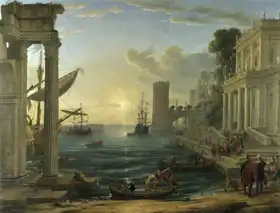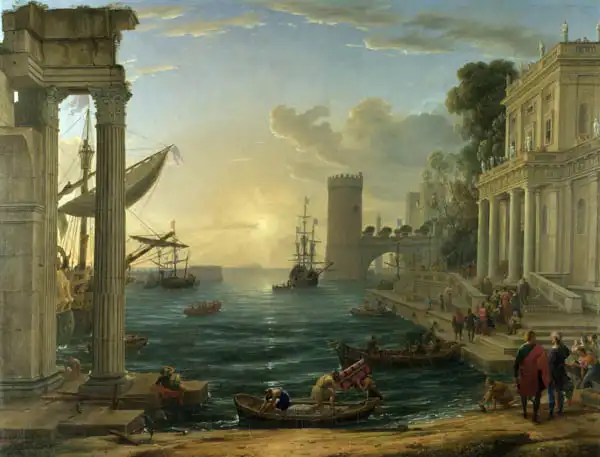About this finishing
Print. The image is printed on the top quality 10-ink HP Z9PS printer on HP matte 270 g / m2 paper. You can choose any size to an accuracy of 1 cm. A margin of 5 cm around the image is added to the size of the motif.


You can find a detailed description about our finishings
here.
The Embarkation of the Queen of Sheba
Date:
1648Medium:
oil on canvasLocation:
National Gallery, London, UKDimensions:
148.6 x 193.7"The Embarkation of the Queen of Sheba" is a famous painting by
Claude Lorrain , created in 1648. This work is a typical example of his
landscape art and depicts an antique subject with a rich and picturesque scenery.
The scene is set in a picturesque harbor where
the sea is surrounded by ancient
buildings and a calm, clear sky. Lorraine's masterful work with color rendering, light and shadow creates an impression of calm and harmony.
The artist paid great attention to details, especially in the landscape and architecture, which contributes to the overall atmosphere of the painting. "The Embarkation of the Queen of Sheba" is an excellent example of Lorrain being able to capture graceful scenery and antique subjects with great artistic sensitivity.
Lorrain painted picture The Embarkation of the Queen of Sheba in 1648. Prevailing color of this fine art print is vivid and its shape is landscape. Original size is 148.6 x 193.7. This art piece is located in National Gallery, London, UK. This image is printed on demand - you can choose material, size and finishing.
Claude Lorrain (1600-1682). Family name Gelée. French landscape artist. He was the most important author of 17th century landscape paintings. He uncovered the beauty of different times of day - because of this, he painted landscapes with light from the west, east or in different weather conditions. Especially at the beginning, he enjoyed painting landscapes with distant views, distant horizons and elaborate details. In the more mature period of his life, he simplified his composition and tried to capture the atmosphere of the place. He painted pictures with tranquil views of the sea combined with monumental architecture (often ruins of ancient buildings - see his most famous painting
The Embarkation of the Queen of Sheba), landscapes and vast groves, all in a poetic and harmonic spirit. His painting techniques had many followers and lasted until the onset of
Impressionism.


